
Sell more, however your customers shop.
Seamlessly blend brick-and-mortar with ecommerce when you unlock Buy Online, Pick Up In Store (BOPIS) functionality on BigCommerce.

Competing With Amazon: How Amazon’s Top Ecommerce Competitors Survive and Thrive
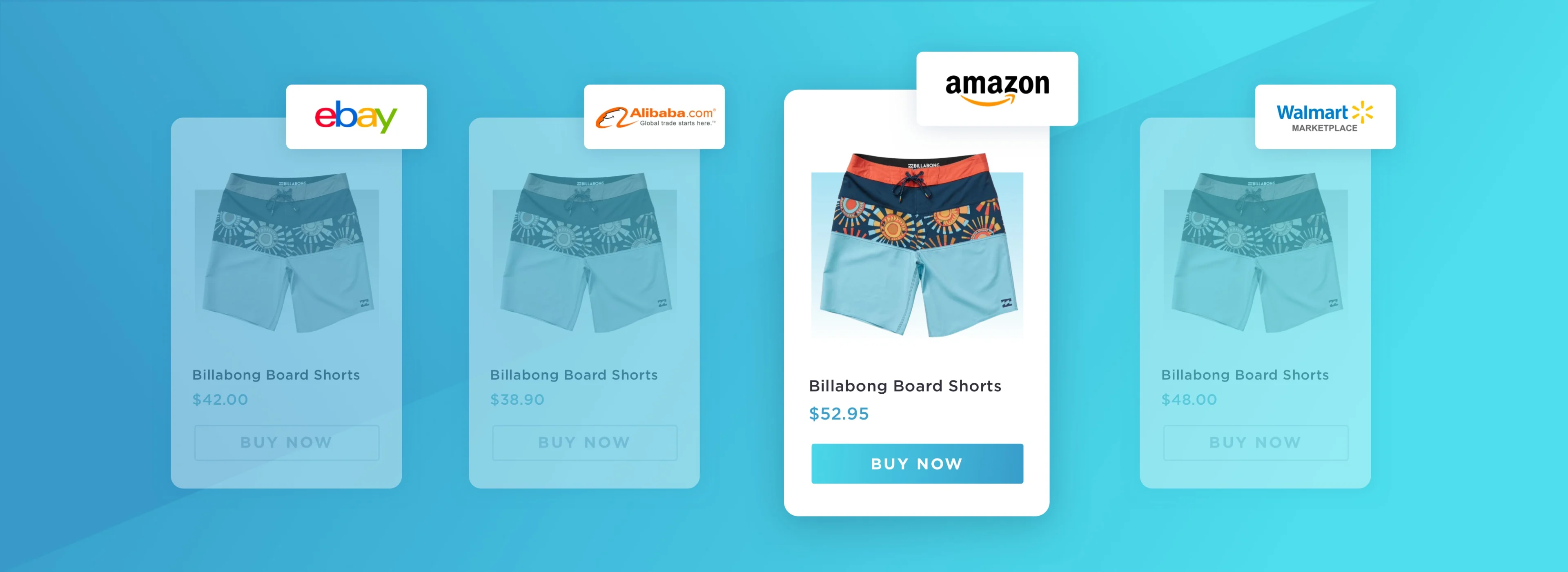

Competing With Amazon: How Amazon’s Top Ecommerce Competitors Survive and Thrive
Get The Print Version
Tired of scrolling? Download a PDF version for easier offline reading and sharing with coworkers.
A link to download the PDF will arrive in your inbox shortly.
Amazon, launched by president and CEO Jeff Bezos in 1994 just outside of Seattle, Washington, is a global ecommerce giant. With $232 billion in net sales annually, Amazon is the most dominant online store in existence today.
In fact, Forbes reported in May that Amazon had surpassed Walmart to become the world’s largest retailer.
Every ecommerce store owner needs to face the reality that they are competing with Amazon.
Your industry and the size of your business doesn’t matter. If you sell physical products online, you’re up against Amazon. They sell everything; you can even buy a pre-built tiny home on their platform.
In the U.S. alone, Amazon controls 45% of the ecommerce market share. That’s up from 34% in 2016 and expected to eclipse 50% by 2021.
Simply put, Amazon is showing no signs of slowing down any time soon.
As big as Amazon is, the company still has its fair share of competitors. Streaming service Netflix competes with Amazon Prime Video. Google Home products compete with Amazon’s virtual assistant Alexa. In the cloud computing arena, Microsoft Azure and Google Cloud both compete with Amazon Web Services (AWS).
And that’s just on the technology side — there are plenty of B2B and B2C ecommerce stores going head to head with Amazon and thriving.
I’ve identified Amazon’s biggest competitors to show you how other websites can still have success in this space. In this guide, I’ll also explain how ecommerce stores can compete with Amazon with actionable, fact-based tips.
If you own an ecommerce website, you need to keep reading. Let’s dive in.
Top Ecommerce Competitors For Amazon
Who is Amazon competing with? You might be surprised. From small niche websites to other retail business giants, Amazon has its hands full with online competitors.
Online stores.
The ecommerce industry is growing at an exponential rate. In fact, retail ecommerce sales worldwide are expected to reach $4.8 trillion by 2021.
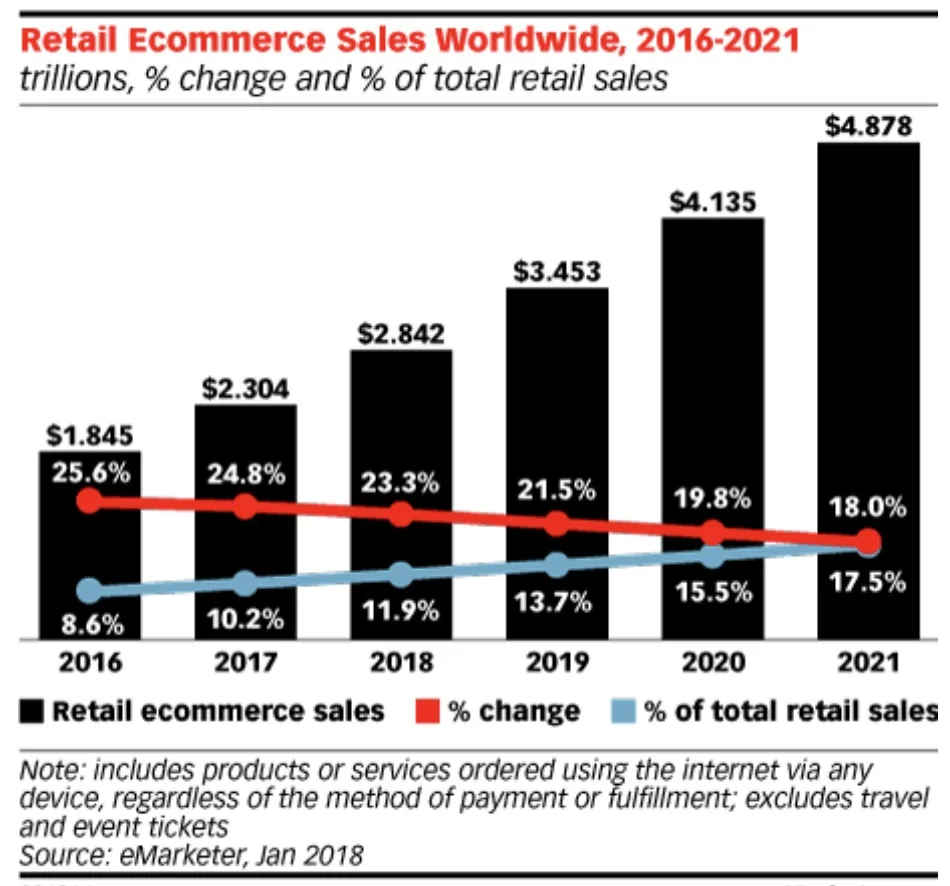
That’s right; nearly $5 trillion is up for grabs!
But take a moment to think about how many online stores exist. No one directly monitors the exact number of ecommerce websites across the globe. However, it’s estimated that there are upwards of 24 million stores selling products on the Internet today.
There is just one Amazon.
Let that sink in for a moment. While Amazon might be dominant, it is just one website out of millions of others selling online.
This is power in numbers at its finest. One of those websites might not take a huge chunk of Amazon’s market share on its own. But collectively, every online store poses a threat to Amazon.
Niche ecommerce stores.
When Amazon first launched back in 1994, the company specialized in selling books online. But today, the company doesn’t necessarily have one clear-cut specialty. As I said before, they sell everything.
But some customers will always prefer buying from niche stores, brands, and manufacturers.
Amazon is obviously very good at what they do. But in terms of knowledge and quality, they can’t compete with smaller niche shops that are experts in a particular industry.
A few examples of niche products include beard oil, CBD for pets, and vegan cosmetics. Consumers are more likely to buy products like this directly from a company that specializes in those industries.
Furthermore, 66% of shoppers worldwide, and 73% of Millennials say they are willing to spend more money on sustainability. So niche ecommerce sites can even charge more money for their products.
Walmart.
Walmart is another global giant. This big-box department store generates $514.41 billion in net sales per year. That’s more than double Amazon, although a large percentage of Walmart’s sales obviously come from brick-and-mortar purchases.
There are more than 11,000 Walmart physical store locations across 27 countries.
While Walmart is best-known for its physical department stores, this retail giant also has a significant presence online. Behind Amazon, Walmart is the second most popular online store in the United States in terms of ecommerce revenue.
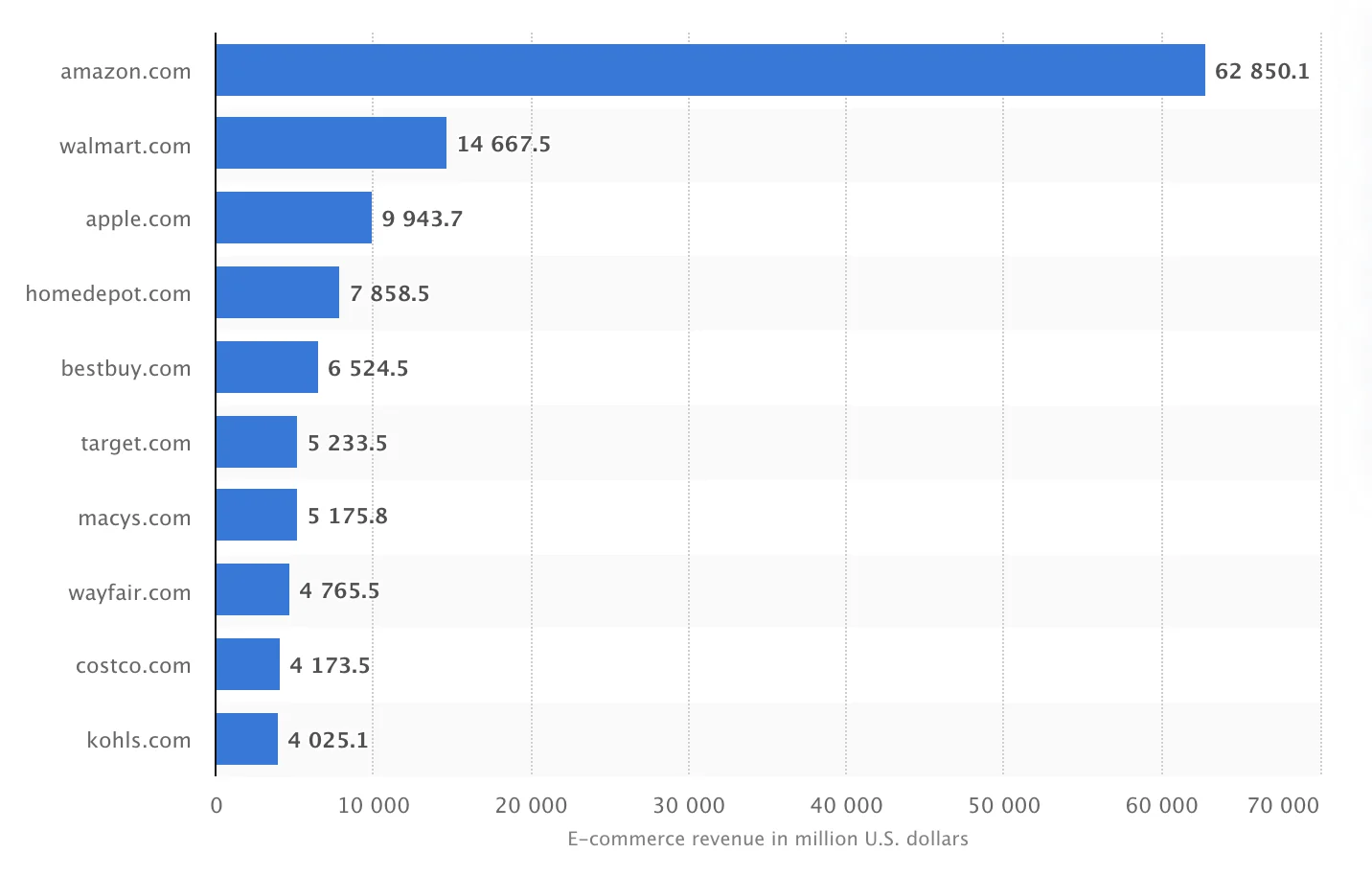
With Walmart’s international presence and customer base, they will be a continuous threat to Amazon in the ecommerce space.
Walmart’s online sales are growing at 40% year-over-year. At this pace, you can expect this giant to take away even more Amazon business in the coming years.
Alibaba / Aliexpress.

Alibaba is a China-based online retailer. This international giant specializes in wholesale selling online, which is a differentiation factor compared to Amazon.
Another unique difference between Alibaba and Amazon is its overall business model. While Amazon is run entirely under one roof, Alibaba is split into separate businesses:
Alibaba.
Taobao.
Tmall.
Alibaba is the B2B focus of the company, while the other branches focus on B2C and multinational brands, respectively.
As of June 2019, there are 755 million Alibaba users worldwide. The company is responsible for 58% of all online retail sales in China.
Alibaba sold $30.8 billion of products on November 13, 2018, the Chinese version of Black Friday known as “Singles Day.”
With an international presence, a dominant market share in China, and B2B sales in addition to B2C focus, Alibaba is a force to be reckoned with. Plus, any website that can do $30 billion in one day can definitely win against Amazon.
Otto.

Otto is a European online retailer. The company is best known for innovation throughout the years to keep pace with the times. At its core, Otto is a trading company, meaning that it sells products from other brands on its ecommerce platform.
It’s essentially a one-stop-shop for buying online in Europe. Some of Otto’s top categories include fashion, electronics (like Apple and Microsoft products), home goods, and sports.
One of the reasons why Otto is so popular is due to its user-friendly interface. The platform makes it easy for consumers to shop online.
In 2019, Otto generated roughly $3.8 billion in revenue from online sales. While this may seem marginal compared to Amazon, it’s still extremely impressive.
Otto has a 13.7% annual growth rate. 72% of their sales come from furniture, appliances, and fashion purchases. This makes them unique compared to Amazon.
JD.

Formally 360buy, JD (Jingdong) is another Chinese ecommerce business. This Fortune Global 500 company is a direct competitor of Tmall, which is run by Alibaba.
At JD.com, consumers can buy a wide selection of products at an affordable rate. The website also has a “buy in bulk” category, which is another reason why it goes head-to-head with Alibaba.
Joybuy.com is also an affiliate of JD. This site is in English and ships to more than 200 countries worldwide. It also offers 24/7 customer service and 30-day returns.
Jingdong has more than 305 million active customers. Its quarterly active customer accounts are increasing at a 22% year-over-year growth rate.
eBay.
Everyone is familiar with eBay. This website was a pioneer in consumer-to-consumer selling through an online marketplace. Over time, eBay has evolved and become more than just a way for consumers to buy and sell their own new or used merchandise.
Today, eBay is used for B2C sales in addition to its traditional C2C model.
In terms of marketplace website visits, eBay is second to Amazon, with just under 20% of the market share.

The site traffic to eBay is impressive. It’s nearly double Walmart, and we’ve already established how successful Walmart is in the online space.
With the ability to bid on products and the unique way for buyers and sellers to connect online, eBay is a top competitor to Amazon.
Flipkart.

Flipkart is a newer ecommerce company compared to some of the other competitors on our list. This Indian-based ecommerce platform was founded in 2007 and quickly became the largest online retailer in India.
In 2018, Walmart acquired 77% of Flipkart’s shares, valuing the company at $22 billion.
With Walmart controlling the majority stake of Flipkart, there’s no telling where the company can go from here.
More than 100 million users are registered on Flipkart. The platform’s user-friendly design, mobile app, and customer service make it one of the up-and-coming Amazon competitors. With such a wide range of products offered through Flipkart, the company is poised for continued success in the coming years.
Rakuten.

Rakuten is a Japanese ecommerce company.
The business generates more than $2.3 trillion per year in retail ecommerce sales. In 2019, Rakuten controlled 14.1% of the total global ecommerce market in terms of retail sales. Furthermore, they are responsible for nearly 10% of the total ecommerce retail share in Japan.
Rakuten generated more than $134 billion in Japanese ecommerce sales alone in 2019.
In 2010 they purchased buy.com to expand its global presence in the United States. Aside from buy.com, Rakuten has acquired other ecommerce companies like PriceMinster (France) and Play.com (UK). They also ventured into acquisitions like Ebates (cash-back rewards) and Viber (VoIP software).
As Rakuten continues to expand and buy companies across varying industries and regions, they will attempt to keep pace with Amazon.
Newegg.

Newegg is a global leader in selling electronics like laptops, TVs, cameras, phones, and computer products online. The company generates $2.7 billion in revenue by offering electronics at an affordable rate.
The fact that Newegg is successful in the electronics space is threatening for Amazon. That’s because electronics is Amazon’s most popular category.
44% of Amazon shoppers in the U.S. have purchased an electronics product through the platform. Clearly, Amazon relies on those sales.
Newegg’s market share takes billions away from Amazon in this category.
How Online Stores Can Compete With Amazon
Now that you’ve had a chance to see some of Amazon’s top competitors, it’s time for me to show you how online stores can compete with Amazon.
You don’t need to be the next Walmart, Alibaba, or eBay to have success selling online. Your online store doesn’t need $1 billion in revenue to go up against this global giant.
All you need to do is follow the lead of successful brands in the space. You can even steal the playbook from Amazon directly and apply it to your business.
These are the top 12 tips for competing with Amazon online.
1. Build a brand. Be the brand!
Branding is powerful. Branding is the reason why Starbucks is able to charge $5 for coffee and why Gucci can sell t-shirts for $500.
You need to establish a brand that your customers recognize and trust. When customers are loyal to a brand, they won’t shop elsewhere, even if the alternative option is cheaper or more convenient.
Amazon sells products manufactured by many different types of brands. But the nature of Amazon’s platform makes every product feel brandless.
It’s tough for customers to tell the difference between one brand or another when they’re shopping on Amazon.
As a result, this creates a significant opportunity for other B2B ecommerce stores to stand out with their unique brands.
2. Focus on customer retention.
Everyone thinks they need to go out and find new customers to be successful. While first-time customers are obviously great, you can’t afford to ignore your existing customers.
Repeat shoppers spend more money and convert at a higher rate compared to new customers.
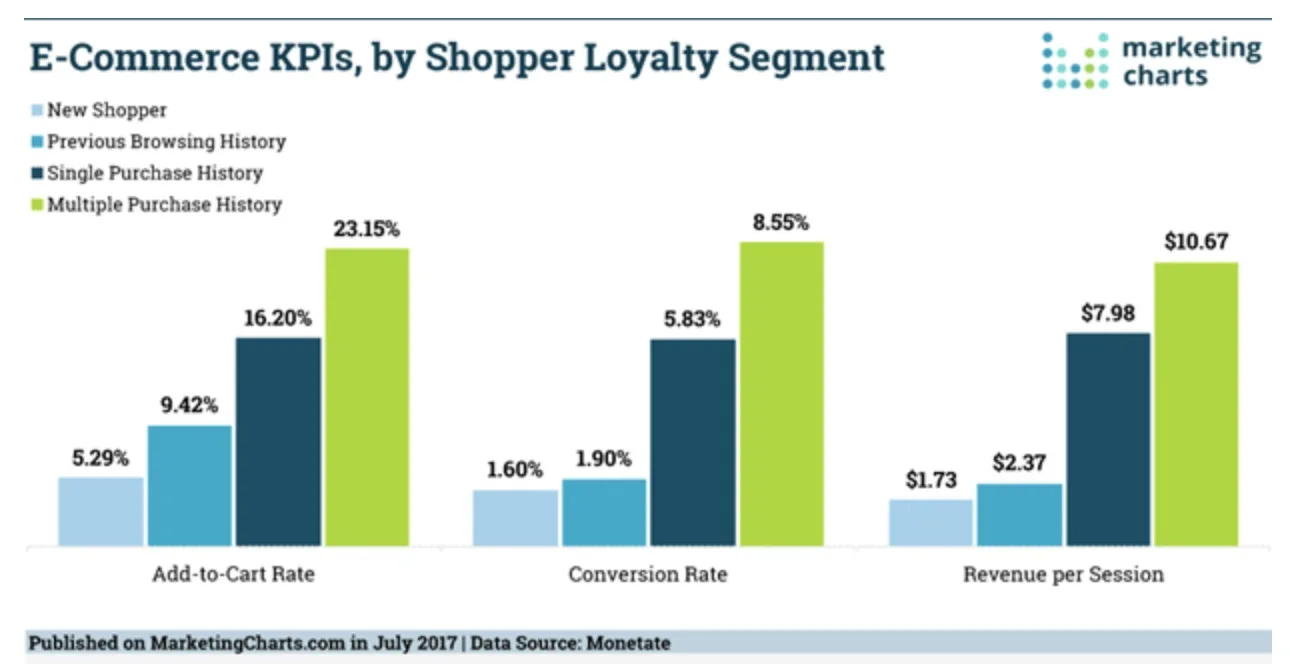
Source: Softclouds
A customer who has purchased something from your site once is already familiar with your brand and products. It’s much easier to sell to them again, as opposed to trying to educate someone else about who you are and what you do.
Research shows that you have up to a 70% chance of selling to a repeat customer, but that number drops as low as 5% for new customers.
Returning customers are 50% more likely to try new products and spend 31% more money than new customers.
Amazon uses its Prime memberships as a way to retain customers. You should come up with a customer loyalty program to encourage customer retention with your online store.
3. Focus on ecommerce SEO
ecommerce SEO is something that needs to be a priority for all B2B ecommerce stores in 2020.
Site architecture.
User experience.
Blogs.
Category descriptions.
Product descriptions.
Keyword research.
Link building.
These are all components of the on-page and technical SEO of your website. If you can master your SEO strategy, you’ll rank high in SERPs for relevant keywords in your category.
The first page of a Google search result captures 71% of clicks. If you don’t appear on this page, the chances of a customer navigating directly to your site are slim.
Without an emphasis on organic search traffic, you’re relying on customers navigating directly to your website and bypassing the search engine. But what about shoppers who aren’t familiar with your brand? You’re alienating those people.
The numbers speak for themselves. 93% of all online experiences begin with a search engine.
Consumers are searching for what you’re selling. You just need to make sure that your ecommerce site is visible in organic search results.
4. Build an email list.
Contrary to popular belief, email marketing is far from dead. It’s one of the best ways for brands to communicate with customers.
When you capture an email address, you’re able to remind that customer about sales or promotions that will entice them to buy. You think about your brand 24/7, but in reality, your customers do not.
Don’t just sit back and wait for them to visit your website. Send them an email to jumpstart the process.
Here are two of my favorite strategies for building an ecommerce email list. First, collect email addresses during the checkout process.
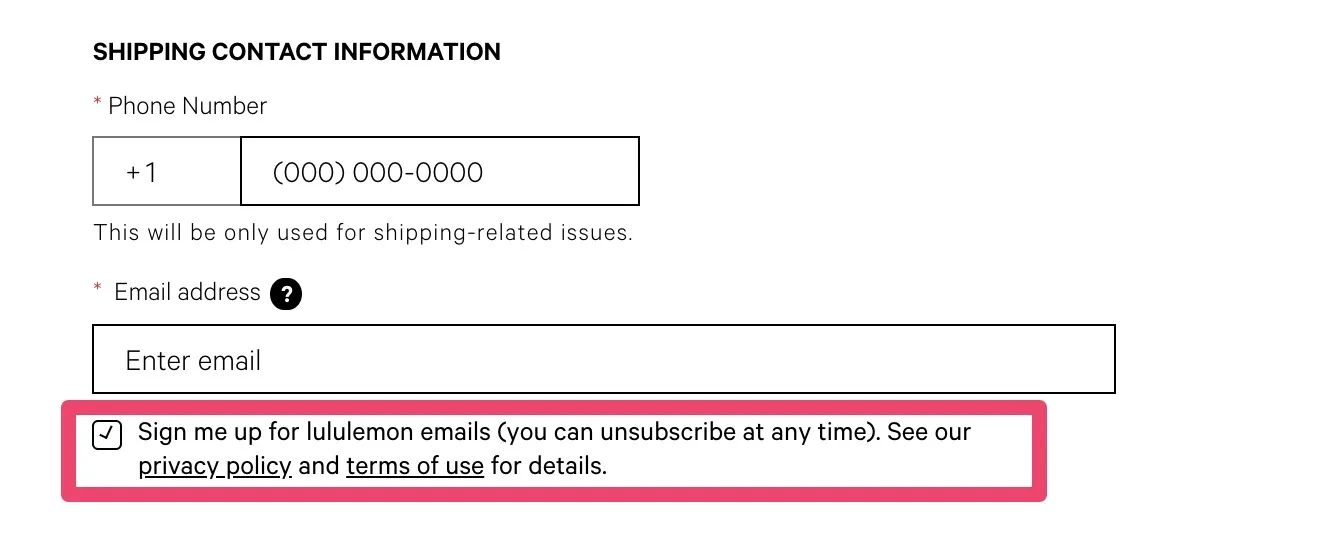
This example was taken from Lululemon. The customer has to provide their email address anyway for the receipt, order confirmation, and shipping updates.
By adding this simple checkbox to the process, it makes it easy for the customer to subscribe. They won’t have to go out of their way to opt-in.
Another great way to add subscribers to your list is by giving them an incentive to join. When someone lands on your website, you can offer something along the lines of a 20% discount for new subscribers.
Not only will this get your customers to sign up, but it also gives them an incentive to buy immediately.
5. Offer enticing discounts.
Everyone wants to feel like they’ve gotten a good deal when they buy something. The last thing you want is for your customers to have buyer’s remorse after shopping on your website. This will give them a bad association with your brand.
One of the reasons why Amazon is so successful is because of their prices. Here’s a look at the most important factors driving purchase decisions on Amazon.
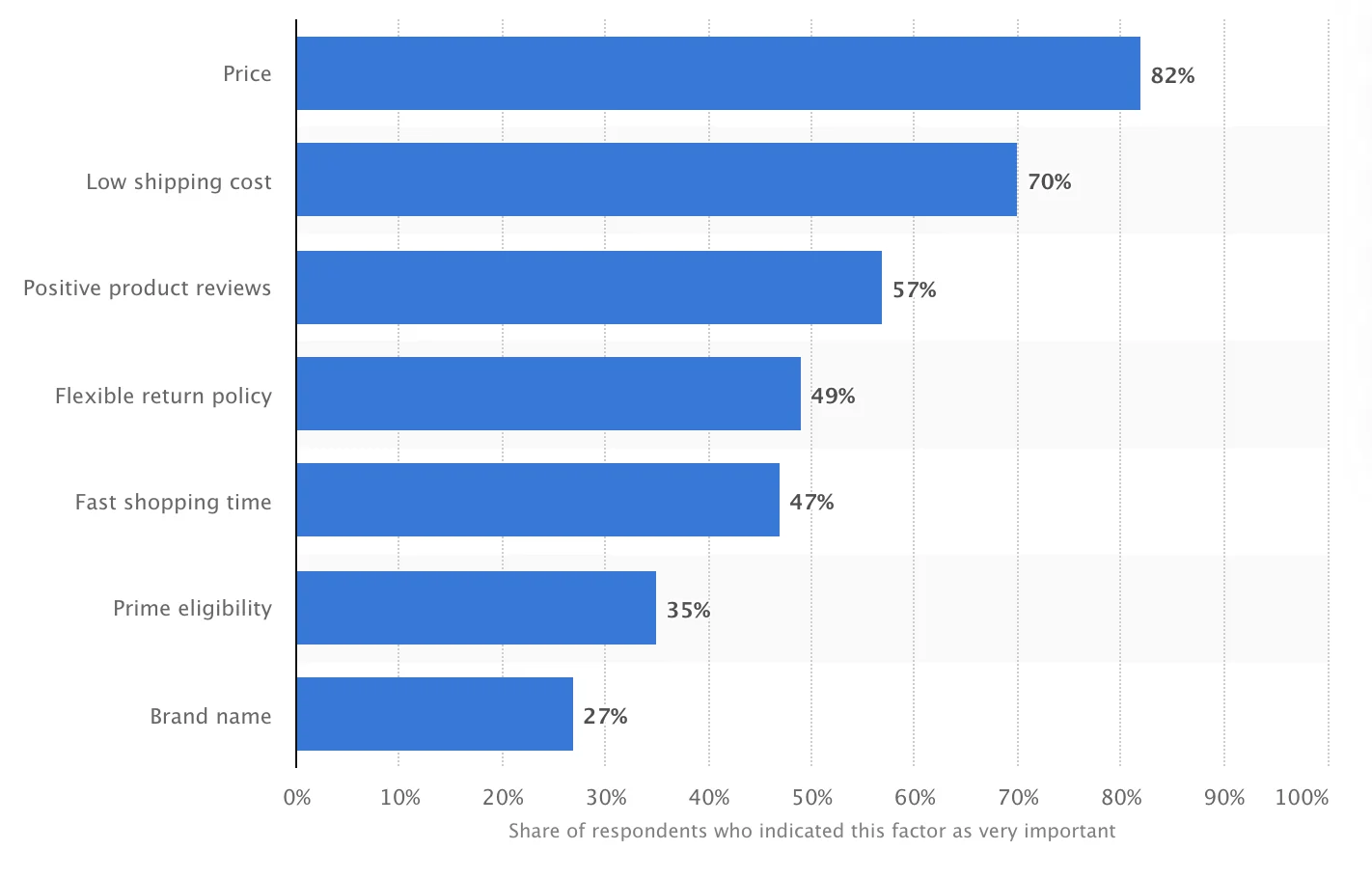
Source: Statista
As you can see, the top two responses on the list were related to cost.
To compete with Amazon’s low prices, you need to offer enticing discounts on your ecommerce website. When a customer feels like they’re getting a good deal, it increases the likelihood that they will convert.
6. Prioritize website user experience.
Amazon is masterful at getting users to convert. The website, mobile app, and single-click checkout process contribute to the company’s success.
To beat with that, your website must accommodate your customers. The pages need to load quickly, and navigation simplicity has to be a priority as well. If your customers can’t find what they’re looking for in just a click or two, then they’ll go elsewhere for their needs.
People don’t have any reason to put up with a frustrating shopping process. Countless websites, including Amazon, make it so easy to shop online.
First impressions matter. It takes just 0.05 seconds for a person to form an opinion about a website. 38% of consumers stop engaging with sites that have an unattractive design. Furthermore, 88% of people won’t return to a website after having a bad experience.
If your website isn’t user-friendly, people will leave — it’s that simple.
7. Don’t sell the exact same products as Amazon.
We’ve already established how vast the Amazon product listing is. They seemingly sell everything and anything under the sun.
But with that said, you should try to avoid selling the exact same products offered on Amazon, especially if you’re an online reseller.
If you have the resources, try to come up with your own product. Otherwise, find ways to carve out a niche in your industry.
You wouldn’t open up a fast-food burger restaurant and put it next to McDonald’s, would you? So don’t try to beat Amazon online at their own game by selling everything that they do. Be unique.
8. Don’t sacrifice margins on Amazon.
When you’re trying to compete with Amazon, it can be tempting to slash your prices. But that’s not a winning strategy if you’re sacrificing your profit margins.
Amazon can keep its prices low based on the sheer volume of sales. But an independent online retailer can’t afford to keep prices that low. Minimal profit margins will put your company at risk of going out of business.
Sure, if you’re priced lower than Amazon for competing products, consumers might choose you over them. But that’s not profitable long-term if you’re not making enough money to keep the lights on.
Come up with a realistic profit margin. Then create a pricing strategy that meets those margins, even after sales, promotions, or discounts.
9. Focus on conversions and funnels.
Conversions are the lifeblood of an online store. Traffic is great, but it’s useless if those visitors aren’t converting.
Here’s an overview of the average ecommerce benchmarks at each stage in the conversion funnel.
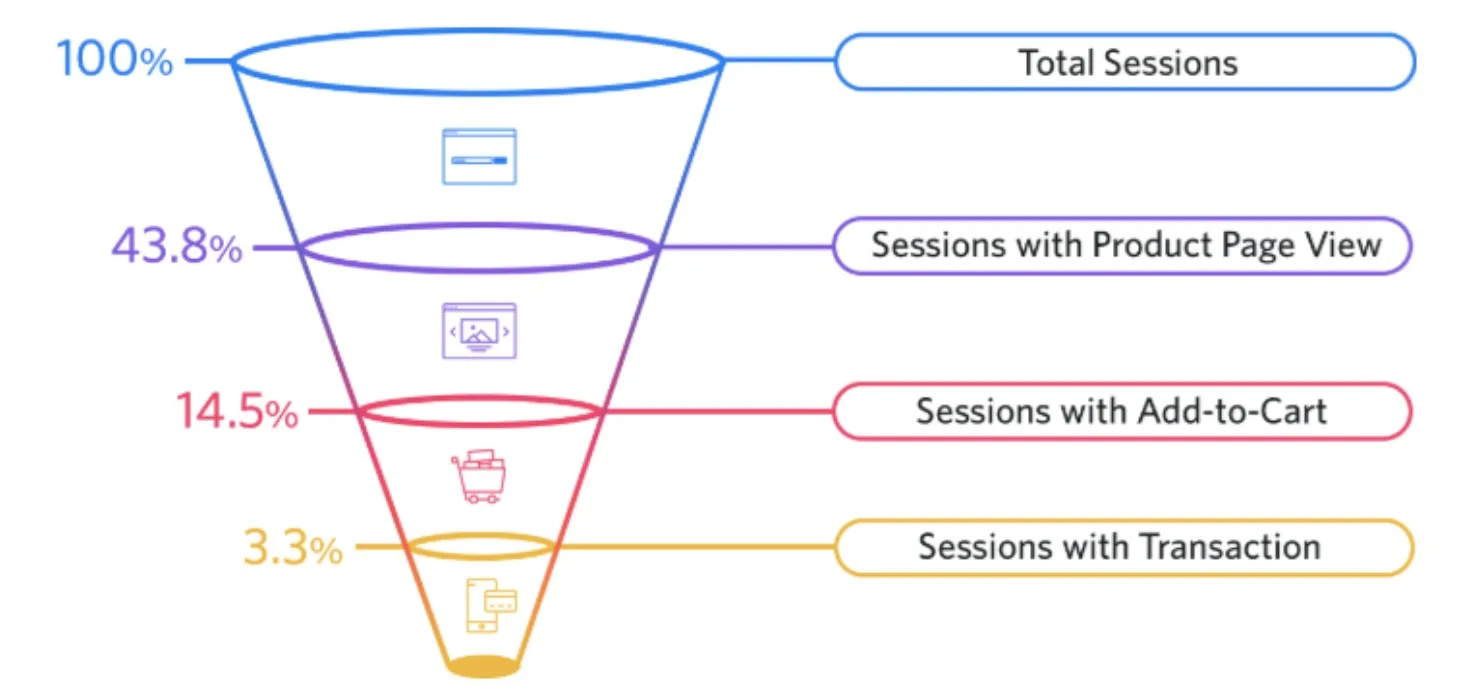
Source: CrazyEgg
How does Amazon compare to this average? Amazon Prime members convert at a whopping 74% rate.
Amazon blows the competition out of the water in terms of conversions. But fortunately, you can model your conversion funnel after Amazon’s to boost your sales.
While 74% might seem unattainable, just think about how much more money you can make by increasing your conversion rate by just 5% or 10%. How much would you make if you doubled your conversions? You can increase ecommerce conversion rates by focusing on funnels and guiding your customers through the checkout process.
The idea here is to figure out where you’re losing customers in the funnel. Simplify the process so the conversion can be finalized in just a couple of clicks. Each added step gives the customer a chance to change their mind and abandon their cart.
10. Have an easy returns process.
Returns are an inevitable part of selling online. Rather than trying to avoid them, you need to make returns as easy as possible for the customer.
Customer-friendly return policies can be the difference between a conversion and a missed opportunity.
66% of consumers check a company’s return policy before they make a purchase. 80% of shoppers are deterred by brands with an inconvenient return process.
Put yourself into the shoes of a consumer for a moment. They purchased something that they wanted, and for one reason or another, they want to send it back. In some cases, the product could be faulty or short of the customer’s standards.
Regardless of the reason, the customer is already unhappy. Don’t make this worse by forcing them to pay for returns. More than 41% of consumers will only shop from online retailers that offer free returns.
Let them print a free return shipping label. Eliminate restocking fees or other return fees.
Don’t lose a customer over a return. If the process is simple, people will continue to buy from your online store, even if their original purpose was unsatisfactory.
11. Offer 2-day shipping.
Amazon’s delivery service has raised the bar for online shipping practices. Prime members get two-day delivery for their orders. This has become the new standard in the minds of consumers.
To compete with Amazon, you need to offer two-day shipping as well. Here’s the catch — you need to do it for free.
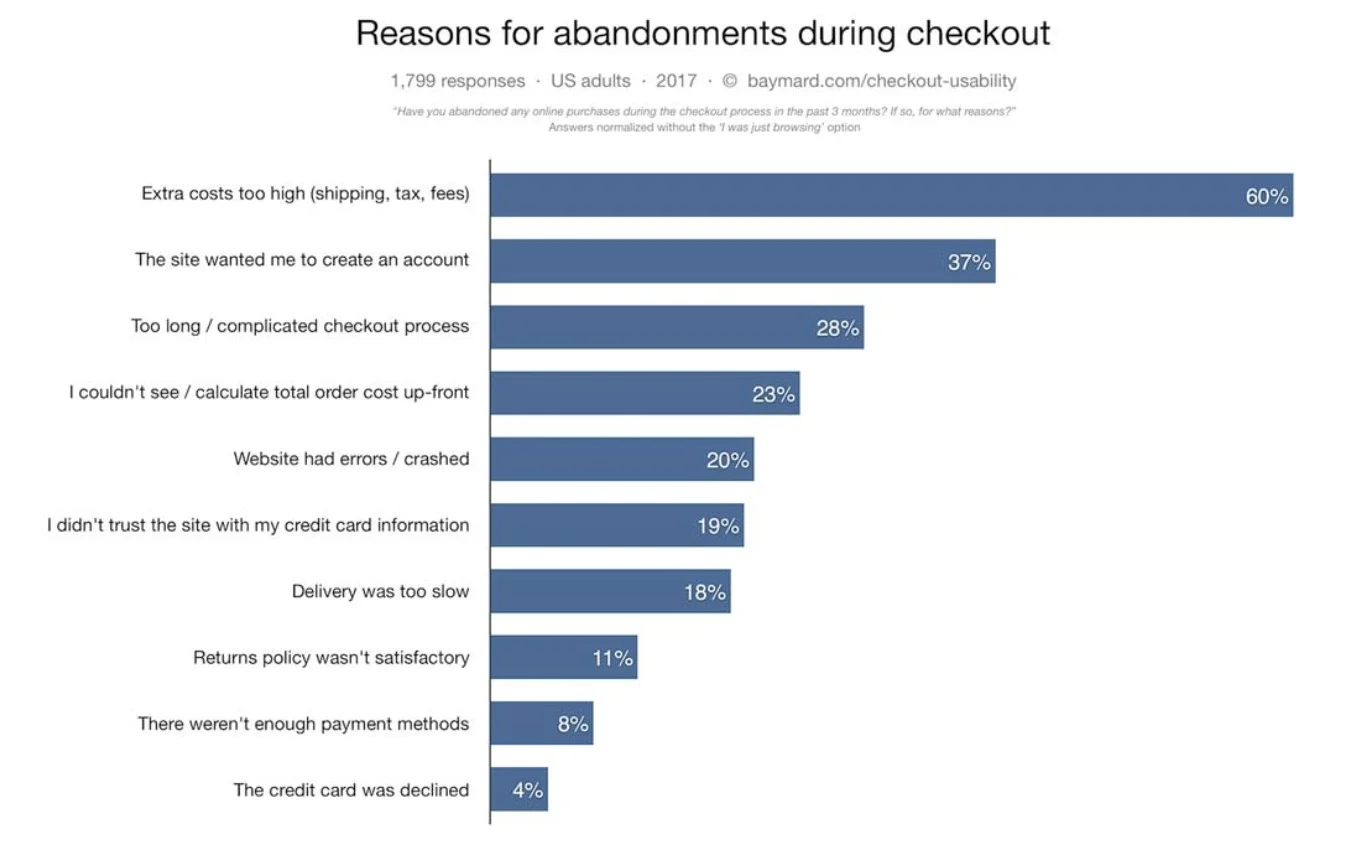
Extra costs, including shipping, are the number one reason for shopping cart abandonment__.
According to this graph, an additional 18% of consumers abandon checkout because the delivery time was too slow.
A recent study suggests that nine out of ten customers say that free shipping is the number one incentive to shop online more frequently.
Don’t worry about losing money on shipping. Just build shipping costs into the base price of your products. Plus, 93% of customers feel encouraged to buy more products when free shipping is offered. Orders shipped for free average a 30% higher value.
There’s no way around it; to compete with Amazon, you need to ship free and fast.
12. Work with marketplaces.
Instead of just selling directly from your website, you can work with other online marketplaces besides Amazon. This is an ideal strategy for smaller brands in niche categories.
Some of the top marketplaces to consider listing on include:
Etsy.
Touch of Modern.
Fancy.
Wayfair.
So, find an online marketplace that specializes in your niche category. Shoppers are already familiar with these platforms and use them to shop online.
Conclusion
Amazon has changed the way we buy online. They’ve raised the expectations for consumers and set the bar for other online retailers.
Although Amazon is a powerful, global ecommerce leader, it doesn’t mean that they are immune to competition. There are plenty of other huge companies out there taking a chunk out of Amazon’s market share.
Every single online store in existence is competing with Amazon. To survive and thrive moving forward, you need to adapt and make changes to your process.
Follow the tips that I’ve outlined in this guide, and you’ll be able to compete with Amazon for years to come.

Duran Inci is an Internet Technology Executive with 15+ years of experience in e-business, E-commerce Systems, Integrations, Custom Programming, SaaS and Digital Marketing including Content Marketing, Paid Search and client acquisition/lead generation. As CEO of Optimum7 , Duran has developed sophisticated processes resulting in the leading-edge execution of technology and marketing strategies. Combined with his strong leadership of the Optimum7 team, Duran has successfully generated many millions of dollars in revenue for his clients. His strong analytical skills consistently result in businesses meeting and exceeding online business objectives.


